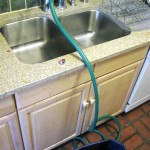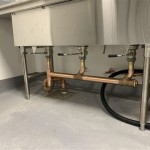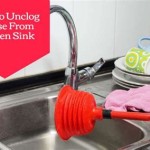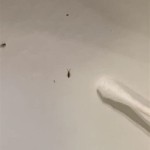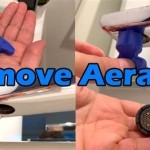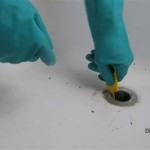Best Ways to Clean Drains in Sinks
Sink drains are a common source of household problems, often leading to slow drainage, unpleasant odors, and, in severe cases, complete blockage. Addressing these issues promptly and effectively is essential for maintaining a functional plumbing system and a hygienic home environment. A proactive approach to drain cleaning can prevent costly repairs and ensure the longevity of plumbing fixtures. Several methods exist for cleaning sink drains, ranging from simple DIY techniques utilizing household items to more advanced methods requiring specialized tools or professional assistance. Understanding the nature of drain clogs and the effectiveness of different cleaning methods empowers homeowners to make informed decisions about drain maintenance.
The composition of materials that cause sink drain clogs varies depending on the sink's location and usage. Kitchen sinks frequently accumulate grease, food scraps, coffee grounds, and other organic matter. Bathroom sinks often collect hair, soap scum, toothpaste, and other personal care products. Over time, these materials can solidify and accumulate within the drainpipe, restricting water flow and leading to backups. Identifying the likely cause of a clog can inform the selection of the most appropriate cleaning method. Prevention is also crucial. Strategies such as using drain strainers, avoiding pouring grease down the drain, and regularly flushing the drain with hot water can significantly reduce the frequency of clogs.
Boiling Water Flush
One of the simplest and most readily available methods for clearing minor drain clogs involves flushing the drain with boiling water. This method is particularly effective for dislodging grease and soap scum build-up. The high temperature of the water helps to melt these substances, allowing them to be washed away more easily. To perform this method, carefully boil a kettle or pot of water. Slowly pour the boiling water down the drain in stages, allowing each stage to sit for a few seconds to work on the blockage. It is important to exercise caution when handling boiling water to avoid burns. This method is generally safe for most types of pipes, but caution should be exercised with PVC pipes, as prolonged exposure to boiling water may soften or warp them. If the initial flush does not clear the clog, repeat the process a few times. This method is most effective for smaller, localized clogs and may not be sufficient for more severe blockages further down the drainpipe.
Before using boiling water, ensure the sink and surrounding area are clear of any flammable objects or materials. Always pour the water slowly and steadily to minimize the risk of splashing. If the sink is made of porcelain, gradually increase the temperature of the water to avoid cracking the material due to sudden temperature changes. For PVC pipes, consider using hot tap water instead of boiling water to mitigate the risk of damage. If the boiling water method does not resolve the clog after several attempts, it is likely that the blockage is more substantial and requires a different approach.
Baking Soda and Vinegar Solution
A widely recognized and environmentally friendly drain cleaning method involves using a combination of baking soda and vinegar. This method relies on a chemical reaction between the two substances to generate carbon dioxide, which creates pressure that can help dislodge clogs. To perform this method, first pour about one cup of baking soda down the drain. Follow this with one cup of white vinegar. Immediately cover the drain with a plug or rag to contain the fizzing reaction. Allow the mixture to sit for approximately 30 minutes. After the reaction has subsided, flush the drain with hot water. The bubbling action of the baking soda and vinegar helps to break down grease, soap scum, and other organic matter, while the hot water helps to flush the loosened debris. This method is generally safe for all types of pipes and can be used as a regular maintenance measure to prevent clogs from forming.
The effectiveness of the baking soda and vinegar method can be enhanced by using a plunger after the mixture has sat for the recommended time. The plunging action can help to further dislodge any remaining debris and clear the drainpipe. For more stubborn clogs, the process can be repeated several times. Alternatively, after the initial baking soda and vinegar treatment, pour a kettle of boiling water down the drain instead of hot tap water. This combination can provide a more powerful cleaning action. It is important to note that this method may not be effective for all types of clogs, particularly those caused by solid objects or extensive build-up of non-organic materials. In such cases, a different approach may be necessary.
Using a Plunger
A plunger is a simple yet effective tool for clearing many types of sink drain clogs. The plunging action creates pressure that can dislodge obstructions and restore proper drainage. There are two main types of plungers: cup plungers, which are best suited for flat surfaces like sinks and bathtubs, and flange plungers, which are designed for toilets. For sink drains, a cup plunger is the most appropriate choice. To use a plunger effectively, ensure there is enough water in the sink to cover the cup of the plunger. This creates a seal that allows the plunger to generate the necessary pressure. If the sink has an overflow drain, cover it with a wet cloth to prevent air from escaping. Place the plunger over the drain opening and push down firmly, then pull up quickly. Repeat this plunging motion several times, maintaining a tight seal between the plunger and the sink surface. After several plunges, remove the plunger to see if the water drains. If the water still does not drain, repeat the process until the clog is cleared. It may take multiple attempts to dislodge a stubborn clog.
When using a plunger, it is important to apply consistent and forceful pressure. Avoid plunging too gently, as this may not generate enough force to dislodge the clog. Conversely, avoid plunging too aggressively, as this could potentially damage the drainpipe or connections. The key is to maintain a steady rhythm and apply even pressure. If the plunging action causes water to back up into the sink, it may indicate that the clog is located further down the drainpipe. In such cases, it may be necessary to use a drain snake or seek professional assistance. Regular use of a plunger can help to prevent minor clogs from escalating into more serious problems.
Drain Snake or Auger
A drain snake, also known as a plumbing snake or drain auger, is a flexible tool used to physically remove clogs from drainpipes. It consists of a long, flexible metal cable with a corkscrew or auger-like end that can be inserted into the drain to break up or retrieve obstructions. Drain snakes are available in various lengths and diameters, suitable for different types of drainpipes. Using a drain snake involves carefully inserting the cable into the drain opening and feeding it down the drainpipe until it encounters the clog. Once the snake reaches the obstruction, rotate the handle to engage the auger and break up the clog or hook onto it for removal. After the clog has been dislodged or retrieved, carefully remove the drain snake and clean it thoroughly. Flush the drain with hot water to remove any remaining debris.
When using a drain snake, it is important to exercise caution to avoid damaging the drainpipe. Avoid forcing the snake too aggressively, as this could potentially puncture or crack the pipe. If you encounter significant resistance, try rotating the snake in the opposite direction to dislodge it. It may also be helpful to apply a small amount of lubricant to the cable to ease its passage through the drainpipe. After each use, clean the drain snake thoroughly with soap and water to remove any debris or residue. This will help to prevent corrosion and ensure that the tool remains in good working condition. Drain snakes are particularly effective for removing clogs caused by hair, grease, and other solid objects. However, they may not be as effective for dissolving or breaking down clogs caused by mineral deposits or chemical build-up.
Cleaning the P-Trap
The P-trap is a curved section of pipe located under most sinks. Its primary function is to trap debris and prevent sewer gases from entering the building. Over time, the P-trap can accumulate sediment, hair, and other debris, leading to clogs and unpleasant odors. Cleaning the P-trap is a relatively simple process that can often resolve minor drain problems. Before beginning, place a bucket or container under the P-trap to catch any water or debris that may spill out. Loosen the slip nuts that connect the P-trap to the drainpipes on either side. You may need to use pliers or a wrench to loosen the nuts if they are tightly secured. Once the nuts are loose, carefully remove the P-trap from the drainpipes. Empty the contents of the P-trap into the bucket. Rinse the P-trap thoroughly with water to remove any remaining debris. Inspect the P-trap for any signs of damage or corrosion. If the P-trap is damaged, it may need to be replaced. Reattach the P-trap to the drainpipes, ensuring that the slip nuts are tightened securely. Run water into the sink to check for leaks. If any leaks are detected, tighten the slip nuts further.
When cleaning the P-trap, it is important to handle the drainpipes carefully to avoid damaging them. Avoid applying excessive force when loosening or tightening the slip nuts. If the slip nuts are corroded or difficult to loosen, try applying a penetrating oil to help loosen them. After cleaning the P-trap, it is a good idea to flush the drain with hot water to remove any remaining debris. Regularly cleaning the P-trap can help to prevent clogs from forming and maintain proper drainage. If cleaning the P-trap does not resolve the drain problem, it may indicate that the clog is located further down the drainpipe and requires a different approach.
Commercial Drain Cleaners (Use with Caution)
Commercial drain cleaners are chemical products designed to dissolve or break down clogs in drainpipes. These products typically contain strong chemicals, such as sodium hydroxide or sulfuric acid, that can be effective at clearing certain types of obstructions. However, commercial drain cleaners should be used with caution due to their potential risks. They can be corrosive to drainpipes, particularly older or damaged pipes. They can also pose a hazard to human health if not handled properly, causing burns or irritation to the skin and eyes. Furthermore, the fumes from commercial drain cleaners can be toxic and potentially harmful to the respiratory system.
If using a commercial drain cleaner, it is essential to follow the manufacturer's instructions carefully. Wear protective gloves and eyewear to prevent skin and eye contact. Ensure adequate ventilation in the area to avoid inhaling the fumes. Avoid mixing different types of drain cleaners, as this could create a dangerous chemical reaction. Never pour drain cleaner into a toilet, as this could damage the plumbing fixtures. If the commercial drain cleaner does not resolve the clog after the recommended time, do not attempt to use it again. Consider using a different method or seeking professional assistance. Commercial drain cleaners should be considered a last resort and only used when other methods have failed. Frequent use of commercial drain cleaners can damage drainpipes and lead to more serious plumbing problems in the long run.
Consider the environmental impact of commercial drain cleaners. The chemicals in these products can be harmful to aquatic ecosystems if they enter the water supply. Choose environmentally friendly alternatives whenever possible. Explore enzymatic drain cleaners, which use natural enzymes to break down organic matter without the harsh chemicals found in traditional drain cleaners. These products are generally safer for both the environment and your plumbing system.
Maintaining sink drains effectively involves understanding the potential causes of clogs and implementing appropriate cleaning methods. Regular preventative measures, such as using drain strainers and avoiding pouring grease down the drain, can significantly reduce the frequency of clogs. When clogs do occur, starting with the simplest and safest methods, such as boiling water or baking soda and vinegar, is generally recommended. If these methods are not effective, more advanced techniques, such as using a plunger or drain snake, may be necessary. Commercial drain cleaners should be used with caution and only as a last resort due to their potential risks. By following these guidelines, homeowners can maintain functional, odor-free sink drains and prevent costly plumbing repairs.

How To Unclog Clean A Bathroom Sink Drain 3 Methods

How To Clean Drains Prevent Clogs Expert Tips Tricks

How To Unclog A Sink The Right Way

How Often Should I Clean My Drains At Home

How To Clean Drains With Baking Soda And Vinegar Liquid Plumr

How To Clean A Stinky Sink Drain

How To Clean Drains Prevent Clogs Expert Tips Tricks

How To Unclog A Bathroom Sink Hana S Happy Home

10 Best Ways To Clean Sink Drains Naturally Fix Smelly Drain

How To Clean A Bathroom Sink Drain

